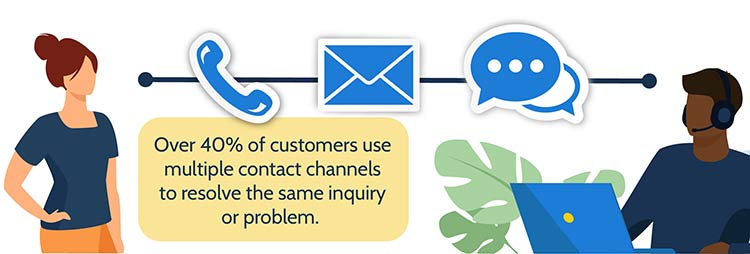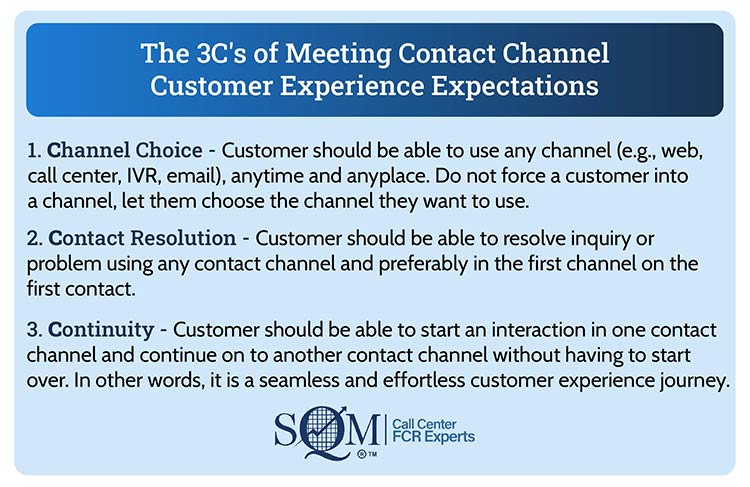Connected Customers
Today's connected customers expect to resolve their inquiry or problem on the first contact regardless of what contact channel they choose to use. Furthermore, SQM research shows the vast majority of customers expect that any contact channel they choose should resolve their inquiry or problem. SQM research shows that 93% of customers using the call center channel and 72% of customers using the website channel expect to resolve their inquiries or problem in one contact.
New types of contact channels are offered and the usage frequency of those contact channels have significantly increased in the last five years with no signs of slowing down. For example, while the call center is still a prominent contact channel, the website channel is now the most used contact channel for resolving an inquiry or problem. In addition, with the emergence of self-service channels (e.g., IVR, website, and mobile), it is becoming more complex and challenging to provide a seamless customer experience (CX) or consistent service within or between contact channels.
Few organizations measure CX using multiple contact channels to resolve the same inquiry or problem. Many organizations describe their customers as web, IVR, email, or call center customers. In other words, they think of customers as an individual channel user versus a customer using multiple channels to resolve the same inquiry or problem. Organizations need to understand the customer journey of using multiple channels to resolve the same inquiry or issue, especially when you consider that over 40% of customers interacting with an organization use multiple contact channels to resolve the same inquiry or problem.

The 3C's of Contact Channel CX Expectations
Figure 1 shows the best practices for meeting CX expectations using different contact channels to resolve their inquiry or problem. SQM calls this the 3C's (i.e., Channel Choice, Contact Resolution, and Continuity) of meeting contact channel CX expectations.
Figure 1: The 3C's of contact channel CX expectations

Tips for Improving Contact Channel CX
Several best practice channel choice options can assist customers in resolving their inquiries or problem seamlessly. Channel choice can be based on customer preference, a recommendation from an agent, or the availability of channels to resolve specific inquiries or problems.
Channel Preference
SQM considers this a best practice, letting customers choose the channel they want to use to resolve their inquiry or problem. The key is to understand customer channel preference for resolving specific types of inquiries or problems and make the preferred channel available and easy for customers to resolve their issues.
Agent Channel Recommendation
A best practice is agent guidance and education. For example, when the agent takes the time to educate the customer on the appropriate contact channel to use in the future for specific inquiries or problems, this will make the customer experience even more effortless. In addition, the vast majority of customers appreciate being educated on the various contact channels available.
Inquiry or Problem Types
A best practice is for an organization to examine all significant inquiry or problem types and determine the appropriate contact channels that can be used to resolve those contacts. For example, if the issue is too complex, it should not be available on a self-service contact channel. Otherwise, these complex inquiries or problems will typically fail on the self-service contact channel and require the use of the call center. However, the customer should be informed on the self-service contact channel that it will be more beneficial to use the call center when their inquiry or problem is too complex.
The best method to measure the customer's experience using contact channels to resolve their inquiry is to conduct a post-contact survey within 24 hours of their transaction and use the One Contact Resolution (OCR) metric. OCR is the metric that matters most to organizations that want to deliver on what customers expect, which is resolving their inquiry or problem in one contact and removing the need for customers to channel hop.
One Contact Resolution
OCR is defined as the percentage of customers who resolved their inquiry or problem on their first contact using only one contact channel. In other words, not having to use another contact channel prior to, during, or after using the single contact channel. The benchmark average for OCR is 62%. So when you ask customers what is most important to them when they use a contact channel – a clear majority of them will say they want to resolve their inquiry or problem on the first contact using only one contact channel.
Given that customers want their inquiry or problem resolved on the first contact using one contact channel, the OCR metric is perfect for measuring whether they received that experience. An essential distinction between First Call Resolution (FCR) and OCR is that FCR only considers the usage of an individual contact channel and OCR factors in using multiple contact channels to resolve an inquiry or problem.
Quick Related Links
First Call Resolution Definition First Call Resolution PPT First Call Resolution Benefits First Call Resolution Strategies First Call Resolution Operating Philosophy Resolution First Call Resolution Formula Calculate First Call Resolution Rate What Is a Good FCR Rate? One Contact Resolution Channel Hopping
